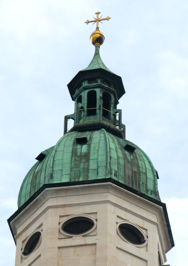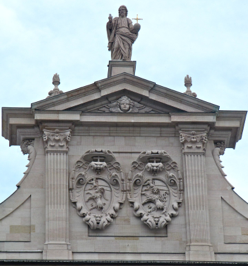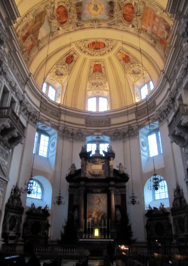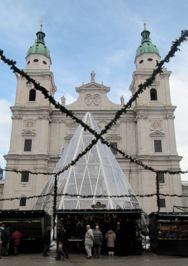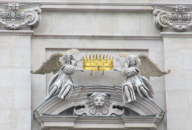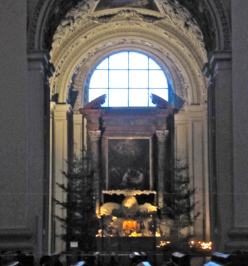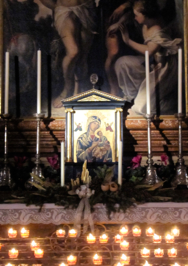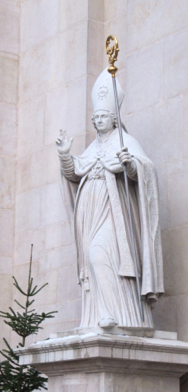salzburg dom
Salzburg cathedral
Salzburg, Austria
europe
Christmas Eve, december 24, 2010


salzburg dom
Salzburg cathedral
Salzburg, Austria
europe
Christmas Eve, december 24, 2010

Midnight Mass at Salzburg Cathedral began at 23:30, which meant that we needed to be standing in line in front of the gates at the entrance to the dom no later than 23:00. This was good information, delivered by Barbara and Robert Seaver from America and Lucca, Italy, who have been in Salzburg for Christmas many years. The four of us walked from the Goldener Hirsch to the dom through the festive streets of the Alt Stadt, standing in front of the gates on the left side of the dom. The minute the gates were unlocked, the crowd surged forward in a quiet and orderly manner, quickly filling the cavernous spaces and the wooden pews. The four of us sat in the back pew of the middle section, a great unobstructed place from which to turn to view the choir and orchestra that played during the service. The church was cold, and everyone remained bundled in their coats and hats. At just past 23:30, the processional of priests and a bishop began. The nineteen were lead by a deacon dressed in a wide red velvet cape, black velvet hat and carrying a mace. Pairs of men in black cassocks covered with white lace-rimmed surplice made their way to the altar along the central aisle. The bishop and two others were in gold vestments, with the bishop wearing a silver and gold mitre and carrying a croisier. The Christmas hymns flowed from the voices and instruments positioned in the choir loft behind us, creating an atmosphere of reverence and deep spirituality. At one point, a priest carrying a sculptured image of the Christ Child laid the baby in a crib, as if in a manger, symbolically recreating the birth of Jesus in Bethlehem. The most moving part of the evening, after the High Mass was complete, was the singing of Silent Night. All the lights in the church were extinguished, except for a few flickering candles, two large votives positioned in small balconies that held mid-apse organ pipes. On the left, a guitarist sat while two male choir members stood. Opposite, in a mirror image balcony, a soprano and mezzo-soprano stood facing the men. With only the soft melodies from the strings of the guitar to accompany the singers, the male voices alternated stanzas with the female voices, a chillingly beautiful rendition of this famous and evocative song. With a celebratory spirit, the crowd dispersed into the night in the earliest hours of Christmas morning.
ABOUT THE CATHEDRAL: The original Salzburg Dom was built between 767 and 774, renovated between 787-821, struck by lighting and burned down in 842, then rebuilt between 1000-1020, its towers built between 1106-1147. With three additional rebuilding campaigns during the Middle Ages, the cathedral had become, architecturally, an ad-hoc Romanesque basilica., Prince-Archbishop Wolf Dietrich (1587-1612) ordered its destruction in the early 17th century. He was a patron and supporter of Modern Italian Baroque architecture, having seen it in Rome, and was responsible for building the Alten Residenz connected to the cathedral today. He hired Italian architect Vicenzo Scamozzi to prepare a plan for a comprehensive new Baroque building. Construction on the cathedral, but was not begun. The successor to Wolf Dietrich, Prince-Archbishop Markus Sitticus von Hohenems (Archbishop 1612-1619) laid the cornerstone of the new cathedral, designed by Santino Solari, who changed the original Scamozzi plan and completed the new cathedral in 1628, in less than 15 years. The present Salzburg Cathedral, measuring 486 feet/142 meters long and 109 feet/33 meters high at the crossing dome is built partially upon the foundations of the old basilica. The Salzburg Dom is the site of Mozart’s baptism in 1758. The new building has stood unchanged except for a restoration to repair the crossing dome after it was damaged during WW II, when one bomb fell on it. Restoration was completed in 1959.
PHOTOS: Left Column: 1. Detail: Baroque architecture of the cathedral designed by Santino Solari in the 17th century. 2. View of the ceiling, the central dome and the dome at the apse of the cathedral, above the altar. 3. A side altar flanked by Christmas trees. Center, Top: View of one of the pair of domes on the tower of the cathedral. Center, Middle: One of several sculptures on the façade of the cathedral, this an Archbishop with his croisier. Center, Bottom: Architectural detail on the façade of the cathedral: Two angels hold the crown, symbolic of the Prince-Archbishop. Right Column: 1. View of the façade of the cathedral that overlooked its protected fountain and the Christmas Market that stood in the square during the Christmas festivities. The swags of greenery decorated the square and formed a floating X. 2. View of the High Altar and dome. 3. Detail: one of the side altars in the cathedral. The painting above this altar is of St. Sebastian. Rows of candles represent prayers left by parishioners.

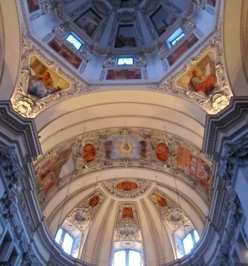
Midnight Mass
